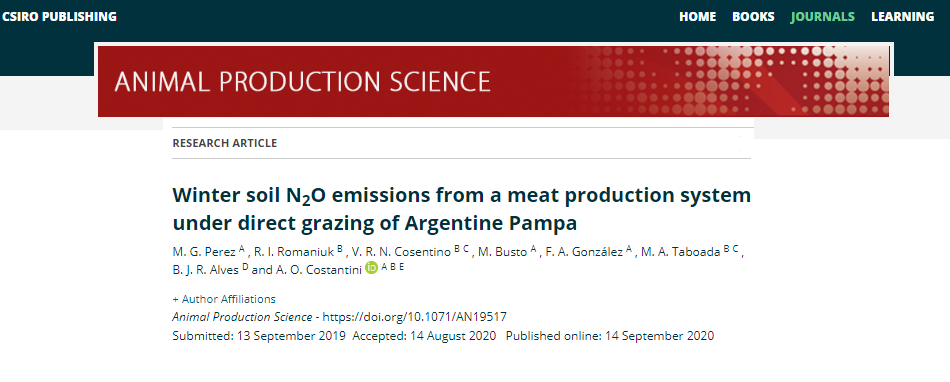In September, the article Winter soil N2O emissions from a meat production system under direct grazing of Argentine Pampa was published. Its authors are researchers and graduate students from Argentina and Brazil.

Abstract
Context: In grazed pasture systems, most nitrogen (N) losses arise from N deposited in the form of ruminant excreta patches. However, during winter, when grassland stocking rate and soil nitrous oxide (N2O) emissions are expected to be low, N2O fluxes from excreta patches could be considered negligible for the calculation of the total emissions.
Aims: The aims of the study were to quantify and compare N2O winter emissions in soils with and without grazing and to study some drivers of N2O emission during a low-temperature period.
Methods: The experiment was performed in the Flooding Pampa, Argentina, in a completely randomised design with repeated measures over time. The treatments were urine, faeces, and control without excreta addition. During winter, 20 gas samplings were made for each treatment, and the results of N2O fluxes were extrapolated to 1 ha.
Key results: Daily N-N2O emissions of the control were 0–10 mg/m2.h. The N-N2O emissions from the urine patches were higher (P < 0.05) than those from faeces and control treatments, with average respective treatment values of 26.13, 5.35 and 2.88 µg N-N2O/m2.h. The N-N2O emissions increased after urine application and fluxes from this treatment were intensified after rainfall. The cumulative N2O emission per chamber was almost 10 times higher in the urine treatment than in the faeces and control treatments.
Conclusion: The air temperature influenced N2O emissions. The accumulated N2O per hectare arising from animal deposition was <5% greater than in the control.
Implications: Although the contribution of animal excreta to soil N2O emissions seems to be low, it could be of relevance once extrapolated to the total area under grazing on the Argentinean pampas (principally Flooding Pampa) where the low-temperatures period is at least 15% of the year.
Additional keywords: grassland soils, greenhouse gases, soil temperature.
The full publication can be accessed at: https://www.publish.csiro.au/AN/AN19517




